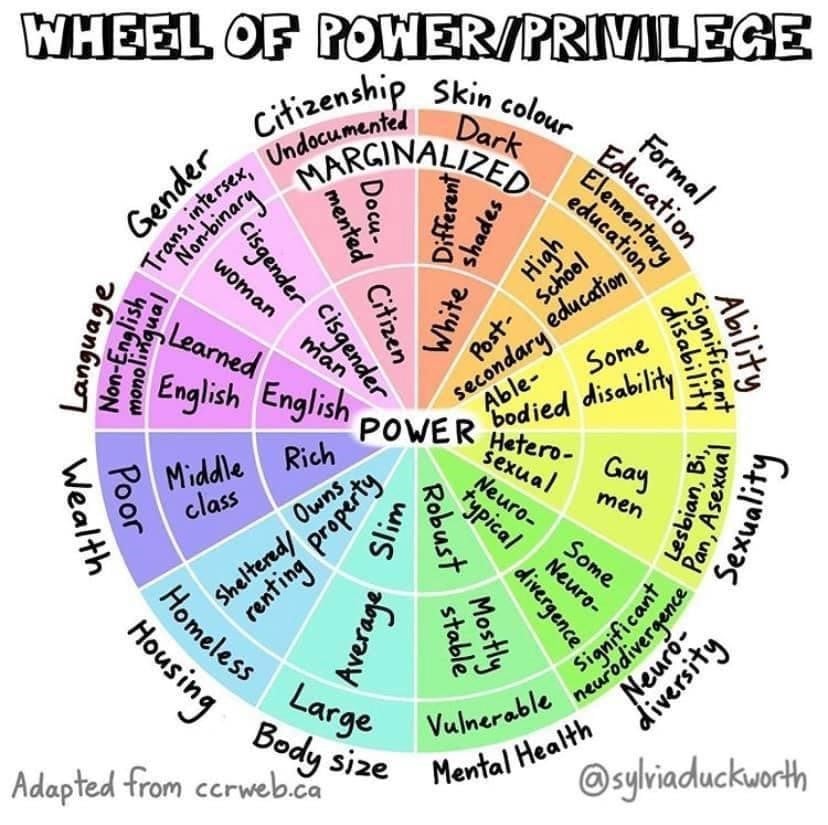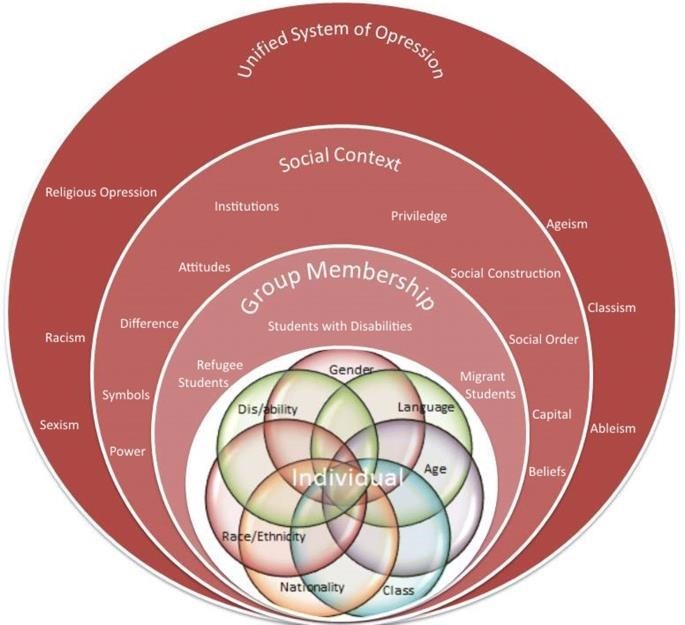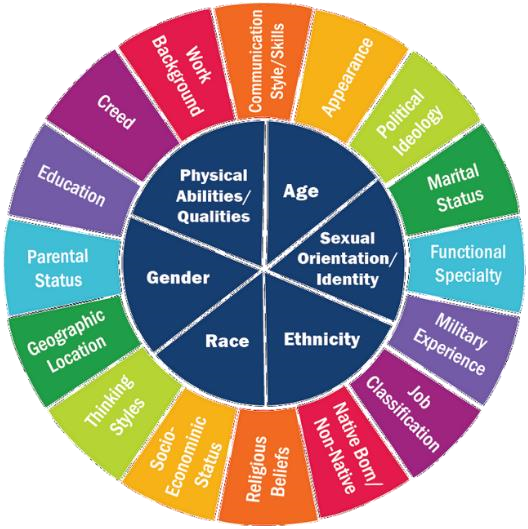Learning Objectives:
- Define the terms privilege, positionality, and intersectionality.
- Identify your positionality as you engage in teaching and research activities.
When we begin conversations about equity, we need to start by considering who we are in the larger context of society. Positionality is the place where you stand in relation to others in society. Your position is determined through the way institutions, laws, and cultures are designed by those in power to give you access to resources, social capital, and rights. (Positionality Media)
Definitions
Privilege
An unearned benefit, advantage, favor, or right that a person receives by nature of their identity.
Key Points –
- Privilege = Power
- Privilege is relative
- Systems that uphold privilege hurt us all
- There is no need to feel guilty about your privilege, or defensive about having it
- We are all responsible for undermining systems of privilege
Intersectionality
The complex, cumulative way in which the effects of multiple forms of discrimination (such as racism, sexism, and classism) combine, overlap, or intersect especially in the experiences of marginalized individuals or groups.
Key Points –
- Term coined by Kimberlé Crenshaw (civil rights activist and legal scholar) in 1989 to provide theoretical explanation for the subordination of black women
- Intersectionality is a lens to view oppression and power
- Issues seen in isolation of one another uphold systems of privilege
- Discrimination is multiplied when more than one form is occurring
Positionality
The ways that differences in social position and power shape identities and access in society.
Key points –
- This term came from the field of Sociology
- All parts of our identity are shaped by socially constructed positions
- Identity influences your outlook on the world
- Understanding positionality helps us challenge our biases
- Positionality can and will change over time
Positionality Statement
Many researchers, particularly in in social sciences, are sharing a positionality statement framing their work. This allows them to admit that research is analyzed through an unintentionally biased lens, and that someone with a different identity could interpret things differently. The researcher will share group identities that might impact their work (racial, cultural, ethnic, religious, economic, educational, etc.). Strengths and challenges of their position are noted. Researchers engage in a reflexive approach to identify their positions about the research topic, the participants involved, and the research process. A positionality statement is a short paragraph, highlighting key themes that the researcher has considered, integrating their understanding of privilege, intersectionality, bias, and other components of their worldview that have shaped their position in relationship to their scholarly work.
- Who am I in relation to this research?
- How does who I am affect how I approach this topic? My interaction with participants? The manner that I conducted this research?
- What have I done to account for, acknowledge, and/ or mitigate my influence on this research?
Example Positionality Statement in Research
Davis, S. M. (2018). The aftermath of #BlackGirlsRock vs. #WhiteGirlsRock: considering the disrespectability of a Black women’s counterpublic. Women’s Studies in Communication 41,269–290. doi=10.1080/07491409.2018.1505678
“Before I present the findings, and in the spirit of self-reflexivity, I acknowledge my standpoint as an educated Black American woman. I am not an avid participant in Black online spaces such as comments sections, but I have observed the interactions of other users, advocated for Black online spaces, and am intrigued by the use of language to mark and protect cultural identities. I acknowledge that my positionality influenced this project to some extent; my member resources proved to be important tools that helped me make meaning of the text.”
What was documented in this positionality statement?
race/ ethnicity, education, gender, personal experience
Positionality in Academic Lectures
Before an academic lecture, faculty are often introduced by sharing educational history and academic and professional accomplishments. Introductions are meant to establish credibility, often highlighting privilege in order to do this. This unintentionally upholds a system of power (and therefore oppression) and is a practice worth further examination.
When a lecturer is speaking about a topic where their worldview and social identity may have had an impact on their learning or interpretation of the topic, it can be important for the lecturer to share some of this information with their audience.
It is also important to remember that this is not required; if you are uncomfortable sharing your positionality with your students or audience, you can take the time to consider:
- Do I have bias around this topic that I could further explore?
- Am I concerned about judgement from students/peers if I share this about myself? Am I concerned about maintaining my position of power? How are my concerns relevant to understanding my own bias and systems of oppression that I experience?
- What circumstances would need to exist for me to feel comfortable making this kind of statement?
A positionality statement can be done verbally or as part of the presentation. There may be topics that require very minimal disclosure. For example, a lecture explaining renal function may not require this level of disclosure, whereas, sharing about one’s research about the effects of poverty on decision making may. There may be times when disclosure is relevant and others, even for the same topic, where it does not.
Example Statement:
Thank you for that introduction. As I prepared my lecture today, I realized I was going to speak about some of the healthcare disparities experienced by marginalized people. As a white person working in healthcare, with the education and career you have just heard about, I think it is important to note that I am at a distance from the experiences of those I am going to talk about. My knowledge of the experiences of those facing disparities has primarily come from my professional work, rather than my personal life.
Before I begin my talk today, I want to share my positionality with you all:
(This can be done verbally or visually on a slide- Please note, an about me slide, listing education, hobbies, a picture of the lecturer on vacation, pets, etc. is not the same as a positionality statement).
- Race/ Ethnicity, Gender, Sexuality, Age, Stage in Career
- Culture, Region, Upbringing, Personal Experience
- Areas of known bias
- Experiences of Oppression, Intersectionality, Privilege
- Reason/purpose in doing this work
References
- The Urgency of Intersectionality – Kimberlé Crenshaw (Ted Talk)
- Positionality Media (Podcasts)
- Queer Race Pedagogy for Educators in Higher Education: Dealing with Power Dynamics and Positionality of LGBTQ Students of Color (International Journal of Critical Pedagogy)
- Intersectionality, Positionality, and Privilege: University of Michigan: Center for Social Solutions (Article)
- Intersectionality: A pathway towards inclusive education? – Edvina Bešić
- Privilege Wheel – York Disability Rights Forum
- Identity, Agency, Positionality and Equitable Instructional Practices – Aims Center
- Learn & Unlearn: Anti-racism Resource Guide



